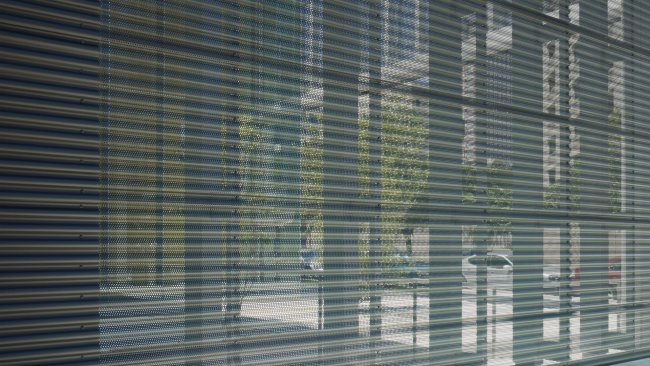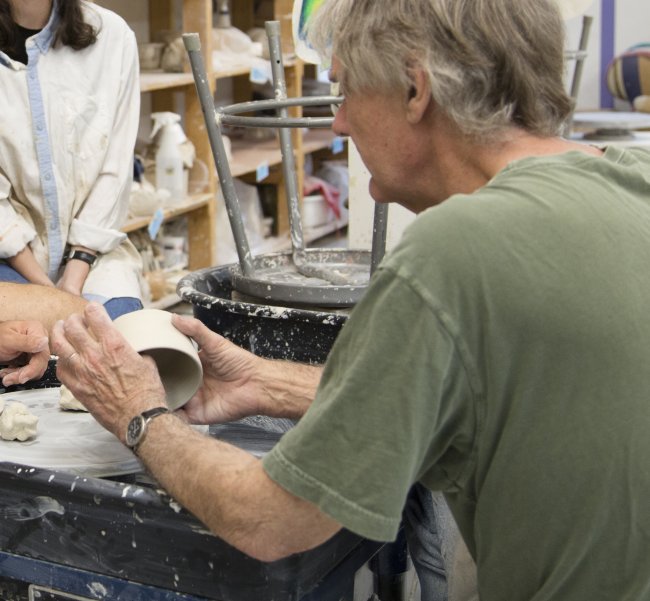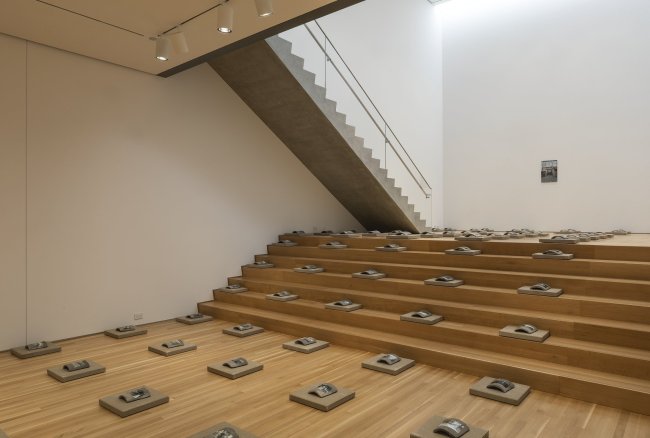The City of Chicago is home to world-class art collections and vibrant arts communities, and the city’s architecture makes for one of the greatest museums of modern architecture in the world. The University of Chicago provides students and faculty with the ability to take advantage of the wealth of resources that the city has to offer, providing students with free access to many area collections, and facilitating archival research and institutional relationships.
City Resources
Architecture in Chicago

Chicago’s buildings are its best-known art collection, especially in the compact lakefront downtown known as the Loop, as well as the expansive Prairie neighborhoods and suburbs that embrace the city. The city’s layout is marked by the 1909 Plan of Chicago by Daniel Burnham, which rationalized the city’s explosive growth since its foundation in the 1830s, and became an international reference point for the new profession of city planning. The Loop is celebrated for pioneering the skyscraper in the late nineteenth century and reinventing it in the mid 20th century under the leadership of Ludwig Mies van der Rohe. In the suburbs, Frank Lloyd Wright launched his career by devising a new kind of house for the Progressive Era, whose inventive form nonetheless had a widespread echo in the city’s working-class bungalow belt.
The city continues to produce innovative architects such as Jeanne Gang and John Ronan, as well as three schools of architecture, and hosts the Chicago Architecture Biennial. Architecture has a remarkably high profile among Chicagoans, who sustain a number of architecture-oriented institutions, including the Chicago Architecture Foundation, the Graham Foundation for Advanced Studies in the Visual Arts, which emphasizes the built environment, the Driehaus Foundation, the Frank Lloyd Wright Trust, the National Public Housing Museum, one of the earliest departments and libraries of architecture at the Art Institute of Chicago, and the national headquarters of the Society of Architectural Historians. They generate an abundance of tours, lectures, conferences, exhibits, and research collections on the built environment.
Art Institute of Chicago
Founded in 1879, the Art Institute of Chicago is one of the world’s greatest encyclopedic museums and home to nearly 300,000 works of art created over 5000 years across the globe. The wide range of its collections and easy accessibility for the academic community–all students get free entry–gives the Department of Art History a seemingly bottomless resource for object study. Complementing the research conducted in its 11 curatorial departments, the Art Institute also features a conservation and conservation science department with multiple conservation laboratories.
Many curators and conservators, some of whom were educated at the University of Chicago, have close relationships with art history faculty, and mentor students, in related fields of expertise. While the Art Institute of Chicago is an incredible resource for the entire city and region, the Rhoades Exchange Program and the Chicago Object Study Initiative (COSI) have deepened the Department of Art History’s relationships with the collection, facilities, and curators for scholarly and pedagogical purposes. Beyond the department’s COSI Fellows and Rhoades Intern, the Art Institute also hosts the Metcalf Foundation Fellows, the Andrew W. Mellon and Rice Foundation Curatorial Fellows, and the Andrew W. Mellon Summer Academy and Undergraduate Curatorial Fellows, some of whom come from the University of Chicago.
Arts Club of Chicago

Established in 1916 in the wake of the Armory Show, The Arts Club of Chicago functions dually as a private club and public not-for-profit, with the first floor of its historic Streeterville home dedicated to the public exhibition of modern and contemporary art, free of charge. The Arts Club offers three to four public exhibitions per year, a permanent collection including work by many modern and contemporary masters, and a diverse calendar of programming offered to its membership, guests, and the public. Over the past century, such luminaries as John Cage, Jean Dubuffet, Gertrude Stein, and Igor Stravinsky have appeared on The Arts Club’s stage, and its permanent collection includes work by Henri Matisse, Alexander Calder, Sigmar Polke, and Natalie Gonchorova.
Chicago Architecture Biennial
The Chicago Architecture Biennial (CAB) takes place every two years at the Chicago Cultural Center and in other sites across the city. Since its first exhibition in 2015, the Biennial has become North America’s largest international survey of contemporary architecture and design, hosting projects by more than 400 architects, designers, and artists from over 40 countries. The artistic directors of the 2023-24 CAB 5: This is a Rehearsal included Andrew Schachman (lecturer of urban design in the Department of Art History at the University of Chicago), avery r. young (who worked as the Arts Incubator Artist-In-Residence at the University of Chicago in 2013), Faheem Majeed, and Jeremiah Hulsebos-Spofford.
Chicago Architecture Center
Formerly known as the Chicago Architecture Foundation, the Chicago Architecture Center (CAC) offers opportunities to explore and appreciate the history of architecture and design within the city of Chicago. This nonprofit cultural organization was founded in 1966 to save Glessner House, a historic home designed in 1885 by architect Henry Hobson Richardson, and convert it into a museum for public education. Every October, CAC organizes Open House Chicago, a festival that opens up many historic buildings throughout the city to free public access. The CAC website provides information on many architects integral to Hyde Park’s current landscape, including Frederick Law Olmstead and Frank Lloyd Wright.
Chicago Cultural Center
The building for the Chicago Cultural Center initially began as Chicago’s first central public library, built in 1897. The actual Cultural Center was established in 1991 by the Chicago Department of Cultural Affairs as a municipal cultural venue that hosts international, regional, and local artists, musicians, and performers for the Chicago public to appreciate and support.The exhibition program at the Chicago Cultural Center encompasses historic as well as contemporary art worldwide, with special emphasis placed on emerging and underrepresented artists who live and work in Chicago and on reach a wide audience in the heart of downtown Chicago. Each exhibition features public events such as gallery tours, public conversations, and hands-on exploration in the Learning Lab. There are many free-access public spaces within the Chicago Cultural Center such as the Claudia Cassidy Theater, a 200-seat theater and stage that opens speaker events and film screenings to the public. Buddy at the Chicago Cultural Center is a shop hosted by the Public Media Institute that gives local artists a platform to sell their work. The Welcome Center provides Neighborhood Cultural Spotlights, where local organizations are nominated by Chicago residents and presented for public appreciation.
DuSable Museum of African American History
The DuSable Museum of African American History, located in Washington Park adjacent to the University of Chicago campus and an affiliate of the Smithsonian Institution, is dedicated to the study and conservation of African American history, culture, and art. Named for Jean Baptiste Point du Sable, a Haitian fur trader and the first non-Native-American permanent settler in Chicago, it was founded in 1961 to celebrate black culture, at the time overlooked by most museums and academic establishments. The museum’s collection includes 13,000 artifacts, books, photographs, art objects, and memorabilia, ranging from US-slavery era relics to objects related to the 1960s Black Arts Movement. The DuSable Museum is the oldest and, before the founding of the National Museum of African American History and Culture in the 21st century, the largest caretaker of African American culture in the United States.
Field Museum of Natural History
The Field Museum is one of the largest natural history and anthropology museums in the world. Founded in 1893 as an outgrowth of the World’s Columbian Exposition, the museum offers opportunities to study the history of collecting and display, as well as access to extraordinarily rich collections of objects from Asia, Africa, the indigenous Americas, the ancient Near East, and the Greco-Roman world. The museum also houses significant collections of ethnographic photographs and film. Curatorial, conservation, exhibitions, and collections management staff have tremendous expertise in art history, anthropology, and related fields, and temporary exhibitions on a variety of topics complement the Museum’s permanent exhibitions on material culture of the Americas, Africa, and Asia.
Gallery 400
Gallery 400 is a contemporary art gallery and educative space created by the College of Architecture, Design, and the Arts at the University of Illinois at Chicago in 1983. The gallery hosts many different exhibitions and events focused on diverse expressions of contemporary art across media, styles, and backgrounds. One example of this focus within Gallery 400’s programming is the Voices Lecture Series, a forum in Chicago for discourse in the field of art.
This series annually presents at least 10 lectures where timely ideas, significant artists, critics, curators, and historians engage audiences in their creative and conceptual processes. Admission to Gallery 400 is free.
Hyde Park Art Center

A leader in advancing contemporary visual art in Chicago since 1939, the Hyde Park Art Center serves as a gathering and production space for artists and the broader community to cultivate ideas, impact social change, and connect through expanded networks. The Art Center functions as an amplifier for today and tomorrow’s creative voices, providing the space to make, see, learn about, and engage art with freedom. Within its facility, the Center inspires creativity through dynamic art-centered interactions, including exhibitions, artist talks, free public events, studio art classes, professional development opportunities for artists, arts education outreach, and an international residency.
IIT College of Architecture

The IIT College of Architecture dates back to the founding of the Armour Institute of Technology in 1890. The school has consistently produced leading architects who have shaped the Chicago skyline throughout the 20th century. In 1938 Ludwig Mies van der Rohe became head of the Department of Architecture at IIT and over his twenty-year tenure developed a lasting pedagogical framework for the program, while ensuring its modernist credentials for years to come. Mies also created a Master Plan for an expanded campus, embracing Chicago’s street grid and featuring numerous buildings designed by him, including the landmarked Crown Hall. The College regularly hosts public lectures by leading architects and architectural historians.
Mary and Leigh Block Museum of Art
The Mary and Leigh Block Museum of Art enriches teaching and learning on the campuses of Northwestern University and in the communities of their surrounding regions by presenting art across time, cultures, and media; convening interdisciplinary discussions in which art is a springboard for exploring issues and ideas; and collecting art that supports the Northwestern University curriculum. The museum aims to be a dynamic, imaginative, and innovative teaching and learning resource at Northwestern through an artistic program that is a springboard for thought-provoking discussions relevant to the curriculum and to our lives today. It seeks to inspire and develop a new generation of artists, scholars, and arts professionals by providing experiential learning opportunities bridging the classroom and the world beyond the campus; and to serve as a crossroad between campus and community, by creating an environment where all visitors feel welcome to participate.
Museum of Contemporary Art Chicago
One of the nation’s largest multidisciplinary museums devoted to contemporary art, the Museum of Contemporary Art Chicago (MCA) offers exhibitions of the most thought-provoking art created since 1945. Complementing the collection and display of painting, sculpture, photography, film, and video, the performing arts program, MCA Stage, is the most active interdisciplinary performing arts presenter in Chicago, featuring leading performers from around the globe. The MCA’s Library and Archives support art history scholarship with access to books, periodicals, and archives including exhibition records, photographs, ephemera, and audio and video recordings. Since its founding in 1967, the Museum of Contemporary Art and the University of Chicago have been closely tied. A number of the MCA’s founders and supporters, including founding board president Joseph Randall Shapiro, have been UChicago alumni. In 1970, the MCA donated Wolf Vostell’s “event sculpture” Concrete Traffic to the University, which was recently conserved and reinstalled in the Campus North Parking Garage adjacent to the Department of Art History. The MCA annually offers the Marjorie Susman Curatorial Fellowship and several internships.
Museum of Contemporary Photography
The Museum of Contemporary Photography (MoCP) was founded in 1976 as a photography gallery for Columbia College Chicago, succeeding the collection of the Chicago Center for Contemporary Photography. The Museum has been collecting photography from the 1980s to present day, amounting to 16,000 works in its permanent collection. Curators at the MoCP place exhibition emphasis on emerging artists’ responses to contemporary issues, highlighting photographers from marginalized backgrounds, and bringing in student audiences. Admission to the MoCP is free and presenting one’s UCID to the museum front desk allows a discount of 20% off on select publications.
National Museum of Mexican Art
Originally named the Mexican Fine Arts Center Museum in 1987, the National Museum of Mexican Art (NMMA) is nestled in Chicago’s Pilsen neighborhood, a large center of Mexican American community within the city. As the first Latine museum accredited by the American Alliance of Museums, the museum has committed to representing diversity within Mexican culture in both its Pilsen community and across national borders. The NMMA is also dedicated to hosting local programming such as school tours, art workshops, artist talks, and an annual Sor Juana Festival—which celebrates the accomplishments of women artists within the Mexican community.
Newberry Library

Serving the public since 1887, the Newberry is a world-renowned independent research library that is home to a collection spanning six centuries. The collection features items such as illuminated medieval manuscripts, rare early maps, rich genealogical resources, and the personal papers of Midwest authors. Free and open to the public, the Newberry offers exhibitions based on its collections; theatrical performances; lectures and discussions with today's leading humanists; seminars and workshops; and teacher programs. The Newberry’s Fellowship Program supports scholarship related to its collections.
Ryerson & Burnham Libraries

The Ryerson & Burnham Libraries comprise one of the largest research collections for art and architectural history in the United States, complementing the permanent collection of the Art Institute of Chicago. The collection contains more than 500,000 print titles, 100,000 auction catalogs, 800 current serial subscriptions, and digital collections. All periods and media are covered, but an emphasis is placed on architecture of the 18th through 20th centuries and 19th century painting, prints, drawings, and decorative arts. Special collections include the Percier and Fontaine Collection of 17th-19th century architectural books, the Mary Reynolds Collection on Dada and Surrealism, the George R. Collins Archive of Catalan Art and Architecture, and the Mrs. James Ward Thorne Collection of illustrated books. Archival collections include artists' and architects' papers, and are notably strong in late 19th- and 20th-century American architecture.
South Side Community Arts Center

The South Side Community Arts Center (SSCAC) was founded by Chicago-based Black American artists Dr. Margaret Taylor-Burroughs, Eldzier Cortor, Bernard Goss, Charles White, William Carter, Joseph Kersey, and Archibald Motley in Bronzeville in 1940. SSCAC is a Chicago Historic Landmark and the oldest African American art center in the United States. Through educational and artistic programs, exhibitions, talks, tours, and more, the center strives to engage, educate and connect community members to African American art and artists. During her teaching position at the University of Chicago’s Art History Department, Dr. Rebecca Zorach (currently a professor at Northwestern University) collaborated with the Visual Resources Center and the SSCAC to create a digital archive (accessible through LUNA) of artworks and ephemera stored at the center.
Stony Island Arts Bank
The Stony Island Arts Bank is a hybrid gallery, media archive, library and community center—and a home of the archives and collections of the Rebuild Foundation, founded and led by artist and faculty member Theaster Gates. Designed by William Gibbons Uffendell and built in 1923, the bank at 68th Street and Stony Island Avenue was once a vibrant community savings and loan. By the 1980s, the branch had closed and the building remained vacant and deteriorating for decades. Reopened in October 2015, the radically restored building serves as a space for neighborhood residents to preserve, access, reimagine, and share their heritage—and a destination for artists, scholars, curators, and collectors to research and engage with South Side history.
The collections include the Johnson Publishing Archive + Collections (books and periodicals donated by the Johnson Publishing Company, publisher of Ebony and Jet magazine), the University of Chicago Glass Lantern Slides (over 60,000 slides of art and architectural history from the Paleolithic to Modern eras donated by the Department of Art History), the Edward J. Williams Collection (4,000 objects of “negrobilia”—mass cultural objects and artifacts that feature stereotypical images of people of color), and the Frankie Knuckles Records (“Godfather of House Music” Frankie Knuckles’ vinyl collection).
Wrightwood 659

Wrightwood 659 opened in 2018 as a private exhibition space displaying architecture and socially engaged art. The interior of the original 1930s apartment building in Lincoln Park was completely reimagined by Pritzker Prize-winning Japanese architect Tadao Ando with the intention to preserve its brick exterior, embracing Chicago’s architectural history. In 2020, the Smart Museum of Art collaborated with Wrightwood 659 to organize the exhibition The Allure of Matter: Material Art from China, presenting works by Chinese artists from the 1980s to 2019 that explore materiality as a subject. This was curated by Dr. Wu Hung, Smart Museum Adjunct Curator, Harrie A. Vanderstappen Distinguished Service Professor of Art History, and Director of the Center for the Art of East Asia at the University of Chicago, with Dr. Orianna Cacchione, then the Smart Museum’s Curator of Global Contemporary Art. The Smart Museum and Wrightwood 659 published a website for The Allure of Matter through which the exhibition can still be experienced virtually.
